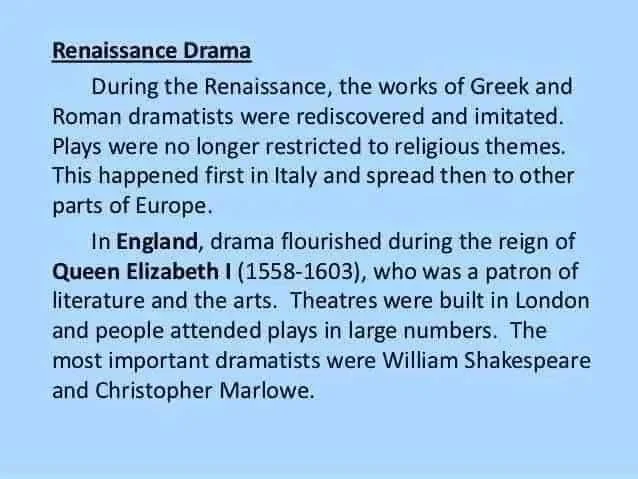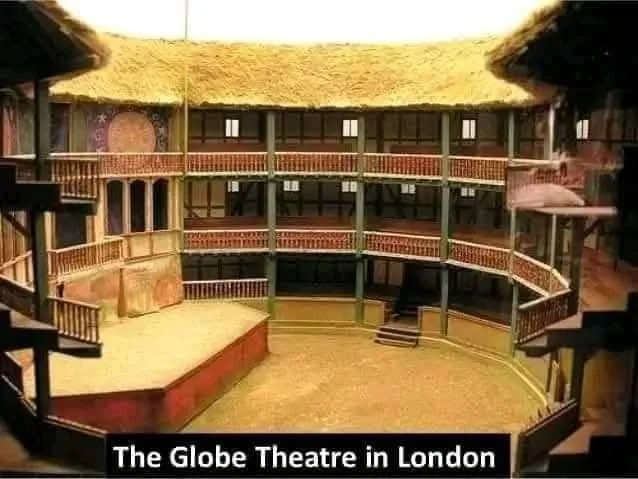Drama and its Elements
Different_Types_of_Literary_Drama
Drama in literature refers to the performance of written dialogue and stage action. It’s a literary genre that allows actors to act out a writer’s words directly to an audience. But there’s more than one type of literary genre – and chances are, you’ve seen examples of them all. Here are some explanations and examples of different types of drama in literature.
#Comedy
Comedies are usually humorous plays. But being funny isn’t the only way to define a comedy! The elements of a comedy include:
Lighthearted tone
Clever wordplay or turns of phrase
Serious topics addressed in a humorous way
Comical misunderstandings
Happy ending
Silly, offbeat characters
Often ends with a wedding, especially in romantic comedies
One of the most famous examples of a comedy is William Shakespeare’s Much Ado About Nothing. Beatrice and Benedick transition from foes to lovers with clever banter and more than a few silly misunderstandings. And, like all proper Shakespearean comedies, it ends with a wedding!
#Farce
A farce is a type of broad comedy. It depends less on a narrative storyline and more on physical humor, sight gags, silly jokes. Here are the parts of a farcical comedy:
Exaggerated humor
Slapstick gags
Nonsensical storyline
Improbable events
One or two settings
Humor is often crude and inappropriate
example of farce Waiting for Godot
Image Credits
For a film reference, think of anything by Monty Python or National Lampoon. On the stage, the absurd humor in Samuel Beckett’s Waiting for Godot (pictured above) is a farcical commentary on life, religion, and human relationships.
#Opera
Operas are dramas in which the characters sing each line rather than speaking. The entire production is set to a musical score. You can tell you’re watching an opera if it includes these attributes:
Musical soliloquies known as arias
Plot-driving passages that can be non-melodic
A libretto (text) set to a musical score
Subject matter that is tragic, comic, or melodramatic
Can incorporate an element of dance, but typically relies on singing performances
Elaborate sets, costume design, and production
One of the most famous operas of all time is Giacomo Puccini’s La Boheme. It tells the tragic story of Rodolfo, Mimi, and the world of French Bohemia. Set to one of opera’s most memorable scores, the story reveals itself over the course of a year.
#Melodrama
When you hear drama, you probably think of melodrama. Melodramas tell a serious story in serious ways. Not sure if a drama is a melodrama? Check if it includes the following:
Character tropes such as heroes, heroines, villains, mentors, etc.
Sweeping stories of romance or serious topics
Larger-than-life plots and circumstances (or very small stories told in big ways)
Exaggerated character reactions
Clear literary themes
Flawed characters who must overcome their faults in order to reach their resolution
Ending that is sometimes happy, sometimes unhappy
Consider Henrik Ibsen’s A Doll’s House when referring to a melodrama. Nora’s over-the-top reactions place the play right into the definition of melodrama. The ending is a mix of both happiness and hope for Nora, and sadness and despair for Torvald.
#Musical_Drama
It’s tempting to put opera and musical drama into the same category. However, their production proves that there are significant differences between the two. But how can you tell a musical drama apart from an opera? Use this checklist:
Periods of standard storyline interrupted by songs
Characters often singing in unison to express feelings
Songs as plot-changing devices
Dramatic or comedic storylines
Catchy, distinctive musical score
Often lots of singing and dancing
Many musicals, such as Les Miserables or Phantom of the Opera, (pictured above) are adapted from longer literary works. Both of these musical dramas express their themes directly through song and progress the plot with musical numbers. They simplify their source material by putting the most important characters and story elements on the stage.
#Tragedy
Just from the word tragedy, you can assume that the ending will be sad. But there is more to a tragedy than a play with no happy ending. You can tell if a play is a tragedy if it includes:
A protagonist with a tragic flaw
Circumstances that quickly get out of control – and not in a funny way
Darker themes than a melodrama, such as human suffering, hatred, or poverty
Features the downfall of a previously heroic or well-liked character
An irredeemable ending that results in one or more characters’ deaths
Reaches a tragic catharsis
Shakespeare has any number of tragedies to choose from. But few can rival Othello for its cruel villain, its hero’s tragic downfall, and its desperately sad ending. Othello loses everything he has ever loved or wanted because he can’t trust that he deserves the life he has.
#Tragicomedy
When you combine the elements of a comedy and a tragedy, you get a tragicomedy! Tragicomedies are more complex than a drama with a few jokes, or a comedy with a serious scene. Some ways to tell if you’re watching a tragicomedy are if it has:
A serious storyline told in a humorous, sardonic, or snide way
Tragically flawed characters whose actions don’t result in death
An ambiguous theme
Broad characters who act in classically comical ways
Neither a happy nor a comic ending
Classic dramas mainly dealt in clear-cut comedy, tragedy, or melodramatic styles. But many modern dramas are considered complex enough to be tragicomedies. Tennessee Williams’ A Streetcar Named Desire has enough elements of a comedy to keep it out of the tragedy genre – but no one can claim than Blanche DuBois is anything but a tragically flawed character. It is the quintessential modern tragicomedy.
#History_of_Drama
The word drama means “action” in Greek. Greek drama began with the work of Aristotle’s Poetics (335 B.C.), which is the oldest recorded work of dramatic theory. The tradition continued throughout Greek culture, marked by the famous laughing/crying masks of drama (Thalia, Muse of comedy, and Melpomene, Muse of tragedy).
The Roman Empire adapted drama into their literary tradition, where it spread into Europe and became known as theater in France and England. The Elizabethan era in particular was a flourishing time for European theater, which set the stage (so to speak) for theater around the world.
Drama Demonstrates the Human Condition
When you read a play or see performances on stage, you’re seeing a dramatization of the human condition. Being human involves laughter, tears, music, and tragedy – and no one knew that more than the Bard himself.










